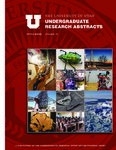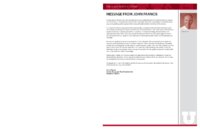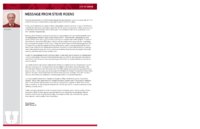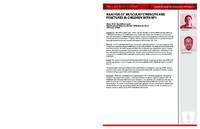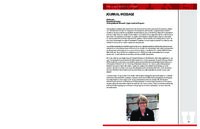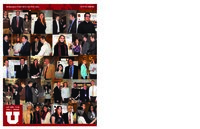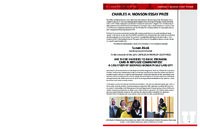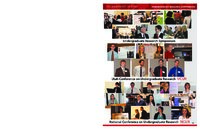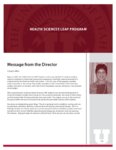Contents | 8 of 16
094_Research Posters on the Hill
| Title | University of Utah Undergraduate Research Abstracts, Volume 10, Spring 2010 |
| OCR Text | Show A Message from President Young…..2 A Message from John Francis.....3 A Message from Steve Roens.....4 Undergraduate Abstracts.....5 A Message from Jill Baeder.....89 Research Posters on the Hill.....93 Charles H. Monson Prize Winner.....119 Undergraduate Research Conferences.....121 Undergraduate Research Scholars.....122 Health Sciences LEAP Program.....123 Psychology Senior Thesis Program.....143 Honors College.....149 Alphabetical Index.....182 |
| Subject | University of Utah -- Students -- Periodicals |
| Publisher | J. Willard Marriott Library, University of Utah |
| Date | 2010 |
| Type | Text |
| Format | application/pdf |
| Language | eng |
| Rights Management | Digital image © copyright 2010, University of Utah. All rights reserved. |
| Holding Institution | Office of Undergraduate Studies Sill Center 195 S. Central Campus Dr. Salt Lake City, UT 84112 Office of Undergraduate Studies Sill Center 195 S. Central Campus Dr. Salt Lake City, UT 84112 |
| Source Material | Bound journal |
| Source Physical Dimensions | 14 cm x 21 cm |
| ARK | ark:/87278/s6dj5fqf |
| Temporal Coverage | Spring 2010 |
| Setname | uu_urop |
| ID | 417441 |
| Reference URL | https://collections.lib.utah.edu/ark:/87278/s6dj5fqf |
Page Metadata
| Title | 094_Research Posters on the Hill |
| OCR Text | Show RESEARCH POSTERS ON THE HILL SPRING 2010 UP ON THE HILL 2010 THE UNIVERSITY OF UTAH RESEARCH POSTERS ON THE HILL 2010 UP ON THE HILL 2010 THE UNIVERSITY OF UTAH RESEARCH POSTERS ON THE HILL 2010 UP ON THE HILL 2010 93 SPINAL MUSCULAR ATROPHY IN DROSOPHILA Spinal Muscular Atrophy (SMA) is the most common inherited form of motor neuronal disease in humans and a leading cause of infant mortality. SMA is charac-terized by a loss of motor neurons which lead to mus-cle degeneration, paralysis, and eventual death by res-piratory failure. More than ninety-five percent of the children born with this disease die; SMA occurs at a rate of one in six thousand live births. SMA is a result of a loss of a gene known as Survival of Motor Neurons (SMN). We hypothesize that SMN is required in motor neurons for proper axonal extension and synapse formation/maintenance, and in muscles to ensure innervation. Using Drosophila melanogaster, we examined the requirements for SMN in motor neuronal develop-ment using RNAi. Preliminary results indicate that, as in higher organisms, a complete depletion of SMN kills the embryo very early. Embryos were collected and injected with varying concentrations of dsRNA that specifically targets the Drosophila SMN transcript for degradation. Embryos were allowed to develop to late stages of development and were then filleted, fixed, stained and imaged on a confocal microscope. Because dsRNA can be injected in the fly at varying concentrations, generating titratable loss of func-tion phenotypes, we observed in pilot studies that 1) SMN is required for axonal extension, but not for motor neuron formation or cell fate specification, 2) that motor axons often fail to extend to their mus-cle target fields and typically fail to form synapses, as evidenced by 3) prolonged formation of myopo-dia, membraneous extensions from the surface of embryonic muscles that typically retract once contact with growth cones is made. We are currently examining genetic mutants for similar defects and are expanding our model of SMA pathology for subsequent modifier screening. THE UNIVERSITY OF UTAH RESEARCH POSTERS ON THE HILL 2010 Priscilla Auduong (Kelley Murphy, Alice Schmid) Department of Human Genetics University of Utah 94 GAMMA-RAY EMISSION BY THE BL LAC MARKARIAN 501 Joshua Binks (Dave Kieda) Department of Physics and Astronomy University of Utah The field of very high energy (VHE) gamma-ray astronomy is very young. The first source, the Crab Nebula, was detected in 1989. Since that time, nearly one hundred sources have been dis-covered. These different sources constitute a vari-ety of astrophysical objects and phenomena. A particularly impressive source of high energy gamma-rays are active galaxies. These sources are bright, variable galaxies with a supermassive black hole (greater than 100 million solar masses) at the center ("nucleus") of the active galaxy. I use the world's most sensitive gamma-ray observatory, VERITAS, to study the origin of VHE gamma-rays. Markarian 501 is an active galaxy at a distance of 500 million light years. In a blazar type AGN, jets emerging from the vicinity of the core's supermassive black hole are chance aligned with the observer. Markarian 501 was observed by the VERITAS TeV gamma ray telescope array between April and June 2009. A total of 1116 minutes of good weather data was selected for this analysis. In this data set, Markarian 501 was detected at a statistical significance of 24.1 sigma, corresponding to a rate of 0.428 gamma-rays/minute. The data indicates that the gamma-ray flux for Markarian 501 appears to be decreasing. In this presentation I will describe the results of this analysis and compare it to previous observations of VHE emission from Markarian 501. RESEARCH POSTERS ON THE HILL SPRING 2010 95 ROYALTY FREE SUSTAINABILITY Reduce, reuse, recycle. It's a familiar and seemingly self-explanatory mantra: people can save natural resources and landfill space, and reduce pollution, by reducing what they use, reusing certain products, and recycling the materials they do use. Unfortunately it's not that simple when it comes to plastics. The plastic recycling process is far more complicated and confus-ing than that of paper, glass or metals, and does not do much to reduce the amount of new plastic products being made. Personal reuse of many disposable plastic products may pose heath hazards. Reducing the amount of plastic that consumers and manufacturers use remains the most viable solution, but there are many challenges in doing so. Reduce, reuse, recycle is a useful mantra, but the average citizen/ consumer requires a bit more information before they can make the kinds of educated choices that will effect the plastic lifecycle in the united states. My undergraduate Honors thesis will take the form of a royalty free website where student groups, community activists, and environmental groups can find free downloadable posters, flyers and graphics that can be used as tools to help educate people in their communities. The site will also feature activity ideas, fact sheets and links to additional resources. My goal is to empower these groups with free graphic communication tools and to help encourage sustainability on a grassroots level. THE UNIVERSITY OF UTAH RESEARCH POSTERS ON THE HILL 2010 Samantha Borstadt (Carol Sogard) Department of Art and Art History, Graphic Design University of Utah 96 CROSS LINKING ANALYSIS OF FLI M AND ITS ROLE IN FLAGELLA SWITCHING Duncan Brunstetter (David Blair) Department of Biology University of Utah Many bacterial cells, such as vibrio cholerae and Escherichia coli (E. coli) use flagella as their pri-mary means of locomotion. These whip like pro-jections of proteins from the cell act as micro-scopic motors driving the cell through its environ-ment. However, the cell does not have a "rudder" with which to direct this motion. As a conse-quence the cells can only move forward, so to better navigate their environment some species of bacte-ria have evolved a mechanism by which change their direction of motion and "steer" towards nutrients or away from toxins. My project involves the specific protein changes that regulate this switching mech-anism in the bacteria Escherichia coli. E. coli flagella can change the direction of their spin from counterclockwise to clockwise. While all of the flagella are spinning in the counterclockwise direction they form a "bundle" which is a group of flagella that are wound together, this bundling allows for forward movement. When the flagella are all spinning clockwise however they do not group together and spin independently of each other causing the cell to "tumble". The switch from counterclockwise to clockwise occurs in the stationary part of the flagella that is embedded in the lipid membrane of the cell. Previous studies have implicated the protein Fli M as the switching regulator so this is the protein that my research focused on. Fli M was analyzed in vivo through the technique of cystine cross linking. This was used to test the proximity of amino acid residues in the proteins during clockwise and counterclockwise motion so that a model could be made of the specific conformational change behind the complex switching motion. RESEARCH POSTERS ON THE HILL SPRING 2010 97 VALIDATION OF A NOVEL SIMULTANE-OUS RATIOMETRIC OPTICAL MAPPING SYSTEM FOR MEASUR-ING MEMBRANE POTENTIALS AND CALCIUM TRANSIENTS IN THE INTACT GUINEA PIG HEART Electro-cardiovascular research requires understanding the electrical activity behind heart muscle contraction. Current imaging techniques take advantage of ratiometric fluorescent dyes and high resolution image capture. Imaging of cardiac activity requires knowledge of both electrical and calcium activities, as such fluorescent dyes have been developed for each. Until now no imaging system has been capable of imaging signals from both the electrical and calcium dye simultaneously. Here a novel imaging system capable of capturing both signals is presented and characterized. The imaging system is proven functional and shortcomings addressed for future development. This technology will provide the ability to advance the field of cardiovascular imaging. Specifically the level of understanding held concerning the relationship of abnormal electrical activity and calcium handling will be increased significantly. THE UNIVERSITY OF UTAH RESEARCH POSTERS ON THE HILL 2010 Zachary Collins (Steven Poelzing) Cardiovascular Research and Training Institute Department of Bioengineering University of Utah 98 PAINTING THE TOWN, INSIDE AND OUT Kurt J. Coppersmith (V. Kim Martinez) Department of Art and Art History University of Utah What started as a grassroots campaign has now become a legitimate force in the community. Once having to go door to door asking business owners to donate the side of their building, Pro-fessor Martinez and her students are now being requested all over the Salt Lake Valley. From con-cept to completion, the projects are part of a course on painting murals, taught by V. Kim Martinez, an associate professor of painting and drawing in the University's Department of Art and Art History. South Salt Lake has been the location for many murals. For example along the south TRAX line are five massive outdoor murals, painted with the goal of bonding the community. Along with outdoor murals, many are now being painted indoors; the SL County Complex, the Columbus Center, and most recently at Primary Children's Hospital. The Department of Gastroenterology requested a mural to cover the walls of their waiting area. Though the mural will be seen by fewer individuals than those outdoors, it is still part of a special community. All of the students are made aware of what the process is about, mak-ing a mural for, and about the community where it will reside. Professor Martinez uses a painting technique that she learned while working with Judith Baca. Baca, a prominent muralist, studied with David Alfaro Siqueiros, one of the great muralists of the 20th century. Martinez is able to share her knowledge and emphasizes the lineage her students now share. Painting these murals gives students the opportunity to get out of the classroom and practice in the real world and, just as important, create a community of their own. RESEARCH POSTERS ON THE HILL SPRING 2010 99 AN EXPLORATION OF THE ARTISTIC APPLI-CATIONS OF MEMS Our research explored the crossroads between art and science to create tiny devices known as MEMS (Micro Electrical Mechanical Systems). These artistic devices are powered by micro charge-pumped actuation of electrons in a scanning electron microscope, utilizing a phenomenon once considered an irritation as a power source. The pioneering artistic application of this micro-technology has inspired our new genre, "kinetic micro sculpture". Micro charge pump actuation is a result of basic electrical properties: charge differential will cause thing to attract or repel. The various MEMS devices layers will charge at different rates and, because of attrac-tive or repulsive force, will move independently of any additional power source. Basically, the device is powered simply by looking at it. Many of the MEMs devices developed at our University now make use of this principle as a power source. These kinetic works move in a variety of ways, such as spontaneous out of plane motion, and demon-strate a broad range of artistic methods. Using polysilicon as a medium, we have made use of such techniques as stippling, shading, negative space, and point of view. When manufacturing MEMS, small punctures known as "etch release holes" are a crucial necessity for the acid baths of production. We took advantage of this requirement, using the holes after the manner of stippling or pointillism to create shadow. A similar process was to use cuts of different depths to create shading; depending on how many layers of polysilicon were left determined the darkness or brightness of that area. To increase brightness further, some works were coated in bright aluminum. These are only a few examples of the many possibilities for artistic expression on the micro scale. It is in effect, a gallery on a chip. THE UNIVERSITY OF UTAH RESEARCH POSTERS ON THE HILL 2010 Kathryn Ecsady (Ian Harvey) Department of Mechanical Engineering University of Utah 100 MEDICAL TOURISM IN INDIA: MAKING THE MOST OF HEALING POWER James Egan (Leslie Francis) Department of Political Science University of Utah In 2004 India welcomed 150,000 foreign patients to its hospitals. Current studies estimate that it will receive more than three times that amount (500,000) this year. Experts predict that by 2012 medical tourists will pump $2.2 billion into the Indian economy. Medical tourism is certainly a booming business in India. But what does this mean for Indians? Is the industry's tremendous growth a positive development for the masses that live too far away from their country's most sophisti-cated hospitals geographically or financially to benefit from them? When thousands of Indians die every year from illnesses that modern medicine has made easily preventable, should the Indian government create policies and use public funds to assist private hospitals that respond predominantly to the demands of the rich and foreign? Is medical tourism healing the world but hurting a nation? These were the central questions of my research. During three months in New Delhi, I researched the development of the medical tourism industry in India and the lack of comparable development in Indi-an public health. I spoke with Indian doctors, travel agents, and academics about this public-private division and followed national news on the subject. This research helped me clarify my initial questions. Then, in an attempt to formulate answers to them, I studied various concepts of nationalism. I read par-ticularly about the development of Indian nationalism. With the ethical dilemmas of medical tourism in mind, I developed a concept of nationalism rooted in cosmopolitanism that I believe should guide the development of solutions to these dilemmas. I concluded that medical tourism will only become an ethical success by becoming a national success-a success that unites Indians by representing what they have to offer the world, but also what they have to offer each other. RESEARCH POSTERS ON THE HILL SPRING 2010 101 OTG, A HERITABLE T-CELL MALIGNANCY IN ZEBRAFISH THAT EXHIBITS APOPTOSIS RESISTANCE Zebra-fish have recently been used as a vertebrate model to study human diseases. In the Trede Lab at the Huntsman Cancer Institute, these fish are used to study leukemia and lymphoma. The project I am cur-rently working on involves a strain of fish known as oscar the grouch (otg) or TC-21. The original otg fish was introduced to a point mutation and developed leukemia, the progeny were then out-crossed to wild-type fish, those offspring were then in-crossed giving a group of obligate heterozygous fish (+/m). The heterozygous fish were then in-crossed and the progeny introduced to an irradiation assay. These fish were irradiated at 30 hours post fertilization (hpf) and then examined to determine if apoptosis in the neural tube cells of the fish occurs, which causes a characteristic curling of the tail. Any fish with straight tails were considered to contain the mutation, which is a homozygous recessive trait (m/m). After using another assay known as acridine orange to confirm the straight tailed phenotype, offspring were collected to use for genetic mapping. Mapping is done using PCR and gel electrophoresis and currently testing these fish is being done start-ing with a broad genomic panel using known zebrafish markers. Also a new step of the project is underway where an otg het. (+/m) was out-crossed to a congenic line of zebrafish known as CG1 and then offspring were in bred again in an attempt to make mapping results more interpretable. TC-21 x CG1 in-crosses are now being used in to examine regions that were largely mono-morphic (therefore uninformative) in the original genomic panel in order to determine the location of the mentioned mutation. THE UNIVERSITY OF UTAH RESEARCH POSTERS ON THE HILL 2010 Katie Gibbs (Kimble Frazer) Department of Oncological Sciences, Huntsman Cancer Institute University of Utah 102 DIFFUSION LIMITED AGGREGATION, ELECTROREHOLOG-ICAL FLUIDS, AND THEIR INSIGHT INTO GLOBAL WARMING Stephen A. Greene (Kenneth M. Golden) Department of Mathematics University of Utah As new issues involving global warming arise, greater insight and knowledge as to the direct and most pertinent causes of global warming is necessary in order to solve these inevitable issues. The focus of my team's study is to find important and applicable insight into these issues by studying the changes taking place in our earth's polar ice caps. While there are many different branches found within polar ice cap research, my research focus is primarily centered on the comparison of two growth processes and their correlation to sea ice microstructures. Because of the similar nature in which all of the said microstructures are grown it is our theory that direct correlations can be drawn. The first of these microstructures is a natural growth process called diffusion limited aggregation (DLA). Unfortu-nately due to its very abstract nature DLA is quite difficult to understand. Therefore, in an effort to understand its properties, our team has written a program that generates diffusion limited aggregates. This allows us to calculate important mathematical properties of DLA. The second growth process is the growth process found in Electrorehological (ER) fluids. This process, which is simply a suspension of extremely fine particles within a variable viscous fluid, is much more simple to study due the fact that it is human generated. Because these two microstructures are grown in such a similar fashion we can draw direct correlations between the two. By drawing these relations between DLA and ER fluids, it is our ultimate goal to gain much better insight into the mathematical properties behind sea ice microstructures and ultimately greater insight into the causes and solutions to global warming. The Tony Cummings Community Based Research Scholar 2009-2010 RESEARCH POSTERS ON THE HILL SPRING 2010 103 HYPERPOLARIZATION OF PROTONS IN ORGANIC SEMICON-DUCTORS We investigate a possible new hyperpolarization tech-nique for the protons in the prototype semiconductor polymer dioctyloxy-p-phenyletrvinylene (DOO-PPV). This luminescent -conjugated organic polymer has been studied by the scientific community as a possi-ble active layer in organic light emitting diodes, pho-tovoltaic solar cells and spintronic devices. At low temperature, we show that it is possible to inject electrons with a specific spin orientation into DOO-PPV using ferromagnetic (FM) electrodes. We observe that this spin polarization is lost within a certain distance (dubbed ‘spin diffusion length') from the injected FM electrode. The reason for this spin polar-ization loss of the electrons is currently unclear. However, it is known that the electron spin is not lost due to spin-orbit coupling in organic semiconductors such as DOO-PPV, because of the weak spin-orbit interaction for light atoms such as H and C, the building blocks of organics. Our hypothesis is that the injected electronic spin is transferred to the nuclear spins of the protons located in the hydrogen atoms, by the Fermi contact hyperfine interaction; thereby polarizing the hydrogen proton spins beyond the normal predicted value for thermal polarization. If our hypothesis is correct, then we should be able to detect the enhanced polarization of the hydrogen nuclei using nuclear magnetic resonance. The hyper-polarization of organic semiconductors is a relatively unstudied field, and therefore highly interesting from scientific viewpoint as well as for applications. Possible applications for the hyperpolarized organic solids may include: quantum computing, and medical imaging. THE UNIVERSITY OF UTAH RESEARCH POSTERS ON THE HILL 2010 Laurel Hales (Brian Saam, T. D. Nguyen, and Z. Valy Vardeny) Department of Physics and Astronomy University of Utah 104 EUGENE ENGLAND'S CALCULATED RISK: THE STRUGGLE FOR ACADEMIC FREEDOM AND RELIGIOUS DIALOGUE Charlotte Hansen (Mark Matheson) Department of English University of Utah A prophet, in simplest terms, is one who desires to change society for the better and call those around them to action. In my research I define the prophetic voice and examine the writings of Eugene England, an influential English and Mor-mon Literature professor. I pose the question of whether England possesses the prophetic voice with his emphasis on the personal essay and promotion of dialogue. Dialogue was a central theme of England's life. He believed that by asking questions and having differing opinions represented that we come closer to God, and find our true selves. Academic freedom, or the right for a teacher to teach and a student to learn, was closely connected with Eng-land's concept of dialogue. To him a university was the best place to ask questions and find truth. When England began teaching and writing, universities were mainly secular. Over four decades in aca-demia, England recognized the need for and championed the value of open dialogue between the sec-ular and spiritual, which is now a conversation more common on campuses. For my research I followed the development of England's prophetic voice by analyzing his writings, lec-tures, journals, and correspondence. I also researched the circumstances concerning his employment and retirement from different universities since he was asked to leave some because of his support of dialogue. There is continuity in his writings, from his first published piece in Dialogue, a Journal that he co-founded, to his last lecture at the Sunstone Symposium, which is completely devoted to the issue of academic freedom in Utah higher education. Speaking out about academic freedom was a risk that England saw as essential, and it is still essential today. By analyzing England's writings and life we can find a way to have greater academic freedom, especially in the field of Mormon Studies. RESEARCH POSTERS ON THE HILL SPRING 2010 105 THE ARCHAEOLOGY OF RANGE CREEK CANYON Range Creek canyon is a tributary to the Green River located in a remote part of central Eastern Utah between Nine-Mile and Desolation canyons. The canyon holds the highest density of undisturbed pre-historic archaeological sites in North America. The sites present in the canyon contain a robust record of human activity dating from as early as 200 A.D. last-ing until approximately 1300 A.D., with the highest occupation occurring between 900-1100 A.D. The archaeology of Range Creek is characterized by numerous isolated pit-house type dwellings, pit-house villages, remote grain storage bins high on cliff walls and rock art sites characteristic of the Fremont archaeological complex. The canyon has been largely protected from vandalism due to its remote location and tenacious protec-tion by the Wilcox family who controlled access to the canyon during the bulk of the 20th century. Archaeological research has been conducted under the Range Creek Research Project under the aus-pices of the Utah Museum of Natural History since 2003. Over 400 prehistoric sites have been recorded thus far, with 3 test excavations conducted by the University of Utah archaeology field school and 2 by the College of Eastern Utah. The University of Utah department of Geography has also operated a geog-raphy field school since 2006 in conjunction with the department of Anthropology's field school, giving students a unique opportunity to work in a multidisciplinary learning environment combining archaeol-ogy and biogeography. The primary research goal of archaeological work in the canyon is aimed at understanding the origins & disappearance of the Fremont archaeological complex, and understanding these events as a function of ecological and environmental conditions. Range Creek offers a unique opportunity to investigate these questions due to its high density and diversity of prehistoric sites, its high temporal resolution, and its lack of impending development. These factors enable a long-term research agenda, something unique in a traditionally time-constrained science. The Ruth Eleanor Bamberger and John Ernest Bamberger Memorial Foundation Scholar 2009-2010 THE UNIVERSITY OF UTAH RESEARCH POSTERS ON THE HILL 2010 Isaac Hart, Katie Thomas (Duncan Metcalfe) Department of Anthropology University of Utah 106 HISTOLOGICAL ASSESSMENT OF SECONDARY DAM-AGE FOLLOWING RAT SPINAL CORD TRAUMATIC INJURY AND TREATMENT WITH PLASMA-DERIVED ANTITHROMBIN III Justin Jensen (Susan Bock) Department of Bioengineering University of Utah Spinal cord injury often results in loss of motor function. Damage sustained to the spinal cord after an injury occurs not only from the initial trauma in the tissue but also from secondary degradation caused by the body's own immune response to said injury. It is believed that the autodestructive events that increase the severity of the injury in the secondary degradation of neural tissue could be avoided if the inflammatory response to the injury were controlled by administration of neuroprotectants. Prevoius studies have reported that intravenous administration of plasma-derived protein antithrombin III (ATIII), an anti-coagulant molecule found in human blood-plasma, reduces the severity of spinal cord injury due to its inherent anti-inflammatory properties. Said properties allow ATIII to act as a neuropro-tectant when administered in high doses which decreases the severity of injury in the long-term as demonstrated in rat models. Though promising, high-dose plasma derived ATIII use as a neuroprotec-tant raises concerns about excessive bleeding, which would render it unsuitable for future therapeutic use in humans. As an alternative, a recombinant ATIII-based molecule (super-beta-ATIII) with advanced surface targeting properties and resistance to neutrophil elastace-mediated inactivation has been developed, which could serve as an effective neuroprotectant at low doses and reduce bleeding risk. To develop expertise in the histological analysis of spinal cord injury and confirm the efficacy of high-dose plasma-derived ATIII, rats received a spinal cord contusion at the T9 level, followed by intravenous administration of 250U/kg of plasma-derived ATIII or vehicle. Following euthanasia on days 1 or 7, the T6-712 segment of the cord was recovered and subjected to MRI and histological analysis. My role is to assess ATIII down-regulation of inflammatory cell recruitment in the immediate (1 day) and short term (7 day) period after trauma. Results from this analysis will be available in Spring 2009. RESEARCH POSTERS ON THE HILL SPRING 2010 107 PREDICTING THE EFFECTS OF LOCKED, PARTIALLY LOCKED, AND LIBERATED MINERALS IN COPPER LEACHING Valuable mineral grains are associated with gangue material in an ore. The valuable mineral particles within a host rock can be classified in three ways. Valuable mineral particle can be fully locked in the interior of the host rock, partially locked within the host rock, or completely liberated from the host rock. The ratio of valuable mineral grain that is partially or fully locked within a host rock particle is size dependent. As the size of the ore is reduced, the amount of liberated and partially locked valuable mineral particle increases. However, there is tremen-dous cost to size reduction of ore. Thus, if the ratios of these three particle states can be modeled in advance of mining production, the optimal ore size can be calculated. Heap leaching simulation were conducted in saturated flow columns to gauge these factors and to investigate the feasibility of a new model that takes into account all three valuable mineral particles states. Preliminary research shows that the newly developed model to be promising and of greater accuracy for heap leaching of ore than traditional models that only account for liberated and locked valuable mineral grains during laboratory testing for extraction rates of the copper ore, chalcopyrite. THE UNIVERSITY OF UTAH RESEARCH POSTERS ON THE HILL 2010 Abraham L. Jurovitzki (Michael L. Free) Department of Metallurgical Engineering University of Utah 108 CERAMIDE-INDUCED DISRUPTION OF ENDOTHELIAL NITRIC OXIDE SYNTHASE DIMERIZATION IN BOVINE AORTIC ENDOTHELIAL CELLS (BAECS) IS NOT SECONDARY TO PEROXYNITRITE FORMATION Chris Kowalski, Nicholas Deeter, Michole Deesing (J. David Symons) College of Health, Department of Exercise and Sports Science University of Utah Health care costs associated with type 2 diabetes place an enormous burden on society. Our laboratory is interested in elucidating the precise mechanisms responsible for impaired vascular function that exist in individuals with diet-induced obesity and type 2 diabetes. Recently we have focused on the contribu-tion to arterial dysfunction and hypertension from a fat metabolite called ceramide. Using pharmaco-logical and genetic approaches to inhibit ceramide biosynthesis in mice, isolated arteries, and BAECs, we have shown that ceramide impairs arterial function by decreasing endothelial nitric oxide synthase (eNOS) activity in a tissue autonomous manner. eNOS dimerization is required for optimal eNOS enzy-matic activity. Peroxynitrite has been shown to uncouple eNOS by disrupting protein dimer formation. We therefore hypothesized that ceramide-induced superoxide anion (O2 -) generation disrupts eNOS dimer formation as a result of increased peroxynitrite accumulation, which lowers NO bioavailability and decreases endothelial function. BAECs were treated for 3 h with: vehicle (V); 500 M palmitate (pal); or pal + the ceramide synthesis inhibitor myriocin (M, 10 M). Relative to V, pal increased: ceramide accumulation (measured by HPLC) by 1.6±0.1-fold (n=6); reactive oxygen species (ROS) generation (measured by DCFDA fluorescence) by 3.2±0.2-fold (n=31); and O2 - production (measured by ESR) by 1.27±0.08-fold (n=12, all p<0.05). These changes were blunted (p<0.05) in BAECs treated with pal + M. Three independent methods to estimate nitrotyrosine formation [i.e., immunoblotting (n=14-18), ELISA (n=16), and immunostaining (n=12)] showed no evidence for pal-evoked peroxynitrite accumulation. Despite the lack of pal-evoked peroxynitrite formation, insulin (n=10) and VEGF (n=10)-mediated increases (p<0.05) in p-eNOS at S1177 and S617, and the eNOS monomer : dimer ratio were prevented (p<0.05) by pal, but were restored by co-incubation of pal + M. These findings indicate that ceramide-evoked disruption of agonist-mediated eNOS phosphorylation and dimerization occurs via a peroxyni-trite - independent mechanism. NIHR15HL091493, ADA7-08-RA-164 RESEARCH POSTERS ON THE HILL SPRING 2010 109 INDUCED FORCE PROMOTES EXTRUSION AND POLYP FORMATION IN MDCK MONOLAY-ERS TO HELP MAIN-TAIN HOMEOSTASIS To maintain the physical health of many organs, the number of epithelial cells that die must match the number of cells that divide. If cell division is slower than cell death, the protective epithelial barrier function is compromised, whereas if cell division rates are faster than death rates, epithelial cancers result. To maintain homeostasis, each dying cell sends sig-nals to its live neighbors, which form an actin and myosin ring that squeezes the dying cell out in a process called extrusion. We have found that cells blocked from apoptosis can still extrude, and that extrusion appears to precede cell death during development, suggesting that cell extrusion may be integral in driving cell turnover during homeostasis. Although many studies have focused on cell death pathways triggered by a variety of apoptotic stimuli, little is understood about what drives cell death during normal homeostatic turnover. We hypothesize that overcrowded cells under tension in the monolayer will get extruded and die subsequently. Thus, we are testing if artificially producing tension in a monolayer can induce extrusion and cell death. I have grown MDCK monolayers on a stretched sili-cone matrix, released the matrix from its stretched state, then fixed and immunostained the monolayers for markers of extrusion and apoptosis. After one hour, we noticed polyps of 2-85 cells had formed and extrusion increased, with less than 1% of the cells in these polyps being apoptotic. Extrusion and polyps were apparent for up to four hours, but were absent by 24 hours post-relaxation. We are cur-rently determining the least amount of force required to induce polyp formation and if the polyp size depends on amount of force. I will test if inhibitors that block extrusion also block tension-induced extruding polyps and conversely, if stretch-activated channel inhibitors block extrusion in response to apoptotic stimuli. THE UNIVERSITY OF UTAH RESEARCH POSTERS ON THE HILL 2010 Patrick D. Loftus (Jody Rosenblatt) Department of Oncology Huntsman Cancer Institute University of Utah 110 CROWDLABS: A PROVENANCE ENABLED WEB REPOSITORY Phillip Mates (Cláudio T. Silva) Scientific Computing and Imaging Institute University of Utah As scientists begin to rely more heavily on com-putational science to research problems, the ease of collaboration and data exploration becomes increasingly important. If datasets, visualization workflows, results, and software libraries are diffi-cult to navigate and share, the exploratory nature of computational science is restricted and the sci-entific community suffers. To counteract this restriction, we present a public on-line repository designed to expose the provenance of data and add a social layer to that data. Our repository not only allows users to easily upload and share their visualiza-tions, datasets, and libraries, but also provides them with the ability to explore and build off of each others work. Wikis, commenting, tagging, and rating are all attached to uploaded data in a social data layer. In addition, the online repository relies upon the infrastructure of the VisTrails workflow manage-ment system, enabling valuable workflow provenance and meta-data to be extracted and made avail-able on the web for users to browse and search. VisTrails support also means that the repository can serve interactive visualizations, corresponding to uploaded workflows, to anybody on the web. We are working to deploy this web architecture for the Center for Coastal Margin Observation and Prediction, the Open Wildland Fire Modeling Community, and for the general VisTrails community. It is expected that providing the scientific community with the ability to easily explore and discuss data will facilitate community growth and improve the quality of research being conducted. RESEARCH POSTERS ON THE HILL SPRING 2010 111 ACCESS GRID RESEARCH- THE CINEMATIC DISPLAY To maintain the physical health of many organs, the number of epithelial cells that die must match the number of cells that divide. If cell division is slower than cell death, the protective epithelial barrier func-tion is compromised, whereas if cell division rates are faster than death rates, epithelial cancers result. To maintain homeostasis, each dying cell sends signals to its live neighbors, which form an actin and myosin ring that squeezes the dying cell out in a process called extrusion. We have found that cells blocked from apoptosis can still extrude, and that extrusion appears to precede cell death during development, suggesting that cell extrusion may be integral in driving cell turnover during homeostasis. Although many studies have focused on cell death pathways triggered by a variety of apoptotic stimuli, little is understood about what drives cell death during normal homeostatic turnover. We hypothesize that overcrowded cells under tension in the monolayer will get extruded and die subsequently. Thus, we are testing if artificially producing tension in a monolayer can induce extrusion and cell death. I have grown MDCK monolayers on a stretched silicone matrix, released the matrix from its stretched state, then fixed and immunostained the monolayers for markers of extrusion and apoptosis. After one hour, we noticed polyps of 2-85 cells had formed and extrusion increased, with less than 1% of the cells in these polyps being apoptotic. Extrusion and polyps were apparent for up to four hours, but were absent by 24 hours post-relaxation. We are currently determining the least amount of force required to induce polyp for-mation and if the polyp size depends on amount of force. I will test if inhibitors that block extrusion also block tension-induced extruding polyps and conversely, if stretch-activated channel inhibitors block extrusion in response to apoptotic stimuli. THE UNIVERSITY OF UTAH RESEARCH POSTERS ON THE HILL 2010 Colin McDermott, JOsh Bross (Beth Miklavcic, Jimmy Miklavcic) Center for High Performance Computing University of Utah 112 3D NEPHROTOXICITY MODEL Tuyet Nguyen, Sean Gowen (Alan Light) Department of Biomedical Engineering, Pharmaceutics and Pharmaceutical Chemistry University of Utah To bring a new drug to market costs over $800 million dollars and 10 years of laboratory research, development and testing. Despite this rigor, many drugs fail strict Federal and Drug Administration (FDA) regulatory requirements during clinical human trials due to incident toxici-ty not predicted in cell culture-based research and testing. Nephrotoxicity, or kidney related toxicity, is commonly manifest as destruction of proximal tubule kidney cells that leads to chronic decline of renal function and, ultimately, renal failure. A number of popular drugs have nephrotoxicity, and new drugs need to be better screened for this problem. Early detection of nephrotoxicity is critical for pharmaceutical and biotech companies when investing the safety and efficacy of a new drug. Dr. Grainger's laboratory at University of Utah is creating an in vitro three-dimensional (3D) model of kidney cells that can be used to test drug nephrotoxicity. The novelty of this nephrotoxicity model lies in extraction of the kidneys' proximal tubules and encapsulating them in a hydrogel to maintain their 3D tissue-like form in culture. This allows kidney cells to retain native cell-to-cell and cell-to-matrix inter-actions as if they were inside of the kidney. This is hypothesized to help them function better as normal kidney cells and therefore advance the prediction of drug toxicity. This presentation focuses on my endeavors to consistently encapsulate mice kidney cells in the range of 1300 reading by Cyquant. Cyquant is an optimized enzyme assay that labels live cells with fluorescent dyes, which is analyzed by a computer software Gen5. Results in the range of 1300 are compared with the standard curve that corresponds to approximately 6000 live proximal tubules. Following the encap-sulation of proximal tubules, chemotherapeutic drugs such as cisplatin and doxorubicin will be used to treat the cells, then to compare their death rates to the literature and to a controlled sample in 2D flask. RESEARCH POSTERS ON THE HILL SPRING 2010 113 THE ROLE OF THE INTERNEURONS AND GRANULE CELLS OF THE DENTATE GYRUS IN SEQUENTIAL LEARN-ING AND PATTERN SEPARATION This study seeks to find the functions of the interneurons and granule cells of the dentate gyrus region of the hippocampus with regard to sequen-tial learning and pattern separation. The subjects of the study were adult Long Evans rats. The subjects were divided into three groups: A control group (N=12), a group whose members had their granule cells ablated using colchicine (N=6), and a group whose members had their interneurons ablated using Sub-stance P Saporin (N=7). The performance of the subjects was measured on two tasks involving an 8- arm radial maze. A different maze was used for each task. In the first task, the subjects were trained to learn a fixed sequence of opening doors. Each subject performed the task 10 times per day for 10 days. The control group and granule cell ablated group performed similarly on the task on the 10th day. The interneuron ablated subjects were impaired on the task compared to the other groups. In the second task, the subjects were presented with a choice between a consistently rewarded arm and a randomly determined arm which was directly adjacent to the rewarded arm. Performance was measured by the number of trials it took before the subject had chosen the correct arm at a rate of 90% over the past 20 trials. Both granule cell ablated subjects and interneuron ablated subjects were impaired on this task. The results of this study suggest that the granule cells and the interneurons of the dentate gyrus serve both separate and overlapping functions and that the interneurons of the dentate gyrus are involved in the processing of sequential information and in pattern separation. THE UNIVERSITY OF UTAH RESEARCH POSTERS ON THE HILL 2010 Jared Roberts (Raymond Kesner) Department of Psychology University of Utah 113 THE ROLE OF THE INTERNEURONS AND GRANULE CELLS OF THE DENTATE GYRUS IN SEQUENTIAL LEARN-ING AND PATTERN SEPARATION This study seeks to find the functions of the interneurons and granule cells of the dentate gyrus region of the hippocampus with regard to sequen-tial learning and pattern separation. The subjects of the study were adult Long Evans rats. The subjects were divided into three groups: A control group (N=12), a group whose members had their granule cells ablated using colchicine (N=6), and a group whose members had their interneurons ablated using Sub-stance P Saporin (N=7). The performance of the subjects was measured on two tasks involving an 8- arm radial maze. A different maze was used for each task. In the first task, the subjects were trained to learn a fixed sequence of opening doors. Each subject performed the task 10 times per day for 10 days. The control group and granule cell ablated group performed similarly on the task on the 10th day. The interneuron ablated subjects were impaired on the task compared to the other groups. In the second task, the subjects were presented with a choice between a consistently rewarded arm and a randomly determined arm which was directly adjacent to the rewarded arm. Performance was measured by the number of trials it took before the subject had chosen the correct arm at a rate of 90% over the past 20 trials. Both granule cell ablated subjects and interneuron ablated subjects were impaired on this task. The results of this study suggest that the granule cells and the interneurons of the dentate gyrus serve both separate and overlapping functions and that the interneurons of the dentate gyrus are involved in the processing of sequential information and in pattern separation. THE UNIVERSITY OF UTAH RESEARCH POSTERS ON THE HILL 2010 Jared Roberts (Raymond Kesner) Department of Psychology University of Utah 114 VEGF GENE THERAPY REVIVES CORONARY ARTERY DEVELOPMENT OF THE CONOTRUN-CAL BANDED CHICK EMBRYO Kyle H Sabey1, (Norman Hu1,2, and David A. Bull1) 1Division of Cardiothoracic Surgery, Department of Surgery, and 2 Department of Pediatrics University of Utah Background. Constriction of the conotruncus (CT) during early embryonic development alters the migration of mesenchymal tissue into the heart causing failure of absorption in the bulbus arteriosus, misalignment of both great vessels, and reduction of coronary vascularization. Objective. We hypothesized that the transfection of VEGF would benefit vascular repair and prolifera-tion following mechanical injury to the developing heart. Design/Methods. The CT of a stage 21 (31/2-d) chick embryo was tied with an overhand knot using 10- 0 nylon suture. Hypoxia-responsive pRTP801-VEGF plasmid was complexed with a reducible cationic polymer, ABP, in HEPES buffer (5 ng/5 mL), and infused into the compact layer of the CT-banded heart at stage 29 (6-d). Normal embryos did not undergo operation. At stage 36 (10-d) India ink in PBS was injected into the left ventricle and subsequently filled the coronary arteries. The heart was then fixed in diastole with 1 mg/Kg diltiazem in 4% paraformaldahyde, and imaged under a stereophotomicroscope. Morphometric analysis (SigmaScan Pro) was performed to determine the maximum coronary artery dis-tance and ventricular vertical length. We also conducted morphologic analysis with H&E and Masson's trichrome stained sections. Data are presented as mean±SEM (n>8) and analyzed by ANOVA. Results. Ventricular lengths showed no statistical difference (p>0.05) among the normal, CT-banded, and CT-banded with pRTP801-VEGF/ABP transfected hearts. Coronary artery length indexed by ventric-ular length was similar between CT-banded VEGF-transfected hearts (0.47±0.04, p>0.05) and normal embryos (0.50±0.02) but markedly decreased in CT-banded hearts (0.34±0.05, p<0.05). The CT-banded hearts with pRTP801-VEGF/ABP treatment showed improvement in coronary anomalies including irreg-ular formation or missing ostium, as displayed in the CT-banded hearts. Conclusions. Coronary arteries in CT-banded hearts with pRTP801-VEGF/ABP treatment undergo pro-portionate vascular growth and penetration comparable to normal development. Improved under-standing of the underlying molecular mechanisms of hypoxia-triggered VEGF signaling can have poten-tial therapeutic implications in various cardiovascular diseases. RESEARCH POSTERS ON THE HILL SPRING 2010 115 MIRROR ILLUSION IN THE CONTEXT OF PERIPHERAL VISION Recent research investigated the integration of visu-al and proprioceptive information through extend-ing the reach of the mirror illusion to include dis-placed and distant gesture prompts. This demon-strated that visual capture, or the perception that the hidden hand is in the location of the reflection, influences judgments about the width of an object made with the hands. In the current series of experi-ments, the relative dominance of visual over propri-oceptive information is explored further. The first experiment has participants move only their left hand, generalizing the results of visual capture to the visible hand. The second experiment is aimed at finding whether the visually perceived width at which one holds one's hands influences the estimated size of a block. The third experiment stimulated visual capture in the peripheral vision in order to simulate a more naturalistic visual-motor environment. In each experiment, a mirror is oriented along the partici-pant's midsagittal plane, with the right hand hidden behind the non-reflective side of the mirror and the left hand and its mirror reflection visible. The participant then stimulates visual capture through perform-ing synchronous finger movements while viewing their reflection. They are then asked to look at a block and to move one of their hands relative to the other so that the distance between the two hands match-es the perceived size of the block. It is predicted that the participants will show errors in this body-based judgment of size, consistent with the visually-specified information about hand location. THE UNIVERSITY OF UTAH RESEARCH POSTERS ON THE HILL 2010 Brooke Shell (Sarah Creem-Regehr) Department of Psychology University of Utah 116 THE IMPACT OF PARITY ON PHYSICAL ACTIVITY IN HEALTHY WOMEN Natalie Van Tongeren (Janet M. Shaw) College of Health, Exercise and Sport Science University of Utah Utah is home to the highest fertility rate in the nation. Each woman of childbearing years is anticipated to have 2.6 children. Due to this high fertility rate, it is important to evaluate the impact parity has on health-related behaviors in women, such as physical activity. In this study, a sample of 158 healthy women aged 39-65 years will report comprehensive physical activity levels across the following age periods: age of menarche to 21 years, 22 to 34 years, 35 to 50 years, and 51 to 65 years. Of particular interest is household and leisure time physical activity. It has been reported previously that women tend to reduce leisure time physical activity as household activity, including the multiple tasks of parenting, increases. Multiple regression analysis will determine whether household physical activity is positively associated and leisure time physical activity is negatively associated with parity after controlling for potential confounding variables such as BMI, smoking status and education level. We hypothesize that the greatest relationship of parity to physical activity will occur between ages 22 - 34 years, when childbirth is most likely. From age 35 - 65, balance may be re-established between household and leisure time physical activity. Because health benefits can accrue from total levels of physical activity, we will determine whether parity impacts combined leisure time and household physi-cal activity levels. We hypothesize that leisure time and household physical activity levels combined is negatively associated with parity, after controlling for education, BMI and smoking status and other important confounding factors. Physical activity is important for many aspects of women's health, and is particularly helpful in preventing excessive weight gain associated with pregnancy. Therefore, this topic has public health implications for women in Utah, especially in light of increasing obesity rates across the state. RESEARCH POSTERS ON THE HILL SPRING 2010 117 REAL AND PER-CIEVED NEEDS: ANALYZING STUDY HALL EFFECTIVENESS Currently, an investigative multimodal six-week writing bridge course is in place at the University of Utah. The course introduces high school students from diverse backgrounds to performance expecta-tions at the university through a multimodal writ-ing- based course. Coupled with traditional class-room multi-modal instruction is a study hall, taking place once a week for two hours. The study hall is organized and staffed by undergraduate writing center consultants with curriculum proffered by the instructor, who saw it as a means to further class-room learning. This UROP research investigated the role of consultants in study hall to find how stu-dents' writing needs, and more importantly, students' perceived writing needs, could be best met through allocated study hall time. Twenty-seven students were asked to evaluate their experience work-ing with consultants in study hall. Data included (1) a mid-semester survey analyzing student comfort with writing, (2) an end-of semester survey assessing students' experience with consultants in study hall, (3) exit interviews discussing students' relationships and work with consultants. Email correspondence between consultants and students was also collected. Finally, this information was combined with ethnographic data examining student behavior with instructors versus consultants. Results demonstrate that all students have a positive view of consultants; however, students were dissatisfied in study hall when they could not see its direct relationship to their course work. The researcher concludes that to improve study hall effectiveness, consultants should work more closely with instructors to have a well-defined purpose and articulated goals when students enter study hall. Also, consultants should regularly consider student feedback to understand students' frustrations and expectations in study hall. Though instructors might think they understand what students need, students' actual needs may be unexpected and transitory. With negotiation between student and instructor preferences, study hall can become a new place of learning rather than merely an extension of the classroom. THE UNIVERSITY OF UTAH RESEARCH POSTERS ON THE HILL 2010 Whitney Wallace (Maureen Mathison) University Writing Program University of Utah 118 PRESENCE OF BIOFILM ON PASSIVATED METAL: AN EXPERIMENTAL APPROACH TO ANALYZE THE SULZER ORTHOPAEDICS INC. RECALL Kassie Woodbury (Roy Bloebaum) Department of Orthopaedics University of Utah It has been estimated that more than 65% of chronic infections are caused by biofilm-dwelling bacteria. Three features define mature biofilm formation: 1) significant extracellular polymeric substance (EPS) production, 2) three-dimensional pillar- or mushroom-like structures and 3) water channel develop-ment. These features allow bacteria to adhere and survive on surfaces and develop interactive bacterial communities. These characteristics also make biofilms particularly resistant to antibiotic treatments, which can lead to increased difficulty in the diagnosis and treatment of patients with biofilm-related infections. The recall of over 17000 Sulzer Orthopedic Inter-Op acetabular components in 2000 due to early implant loosening may have been caused by biofilm contamination related to a change in the pas-sivation process of a portion of the implants. To replicate the manufacturing process of these implants, an n=30 coupons from a standard CDC biofilm reactor system were exposed to a cleaning procedure without nitric acid passivation that was similar to the Sulzer Orthopedics process. The n=30 additional coupons were cleaned and passivated with nitric acid. Coupons from both groups were observed using scanning electron microscopy to confirm the presence of biofilm. On those coupons that were cleaned, 18 of 30 coupons had biofilm. In the passivated group, 11 of 30 coupons had biofilm. There was no sta-tistically significant difference between the groups. These findings suggest that biofilm may have con-tributed to early implant loosening and manufacturers should follow the scientific method of confirm-ing that passivation and cleaning procedures of orthopedic implants are safe, sterile, and biofilm free prior to placement in patients. References: 1. Wolcott, Ehrlich; Biofilms and Chronic Infections, JAMA 2008 2. Bloebaum, Ferguson, Neff, Gorp, Woolley, Hofmann; Bone Viability Determination in Human Cancellous Bone From Patients Undergoing Revision Hip Arthroplasty, J Artho. 2004 RESEARCH POSTERS ON THE HILL SPRING 2010 |
| Format | application/pdf |
| Identifier | 094_Research Posters on the Hill.pdf |
| Setname | uu_urop |
| ID | 417432 |
| Reference URL | https://collections.lib.utah.edu/ark:/87278/s6dj5fqf/417432 |

